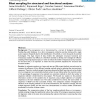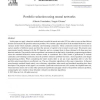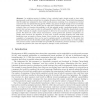642 search results - page 127 / 129 » An Introduction to Evolutionary Programming |
BMCBI
2006
13 years 9 months ago
2006
Background: Genome sequences vary strongly in their repetitiveness and the causes for this are still debated. Here we propose a novel measure of genome repetitiveness, the index o...
BMCBI
2007
13 years 9 months ago
2007
Background: The post-genomic era is characterised by a torrent of biological information flooding the public databases. As a direct consequence, similarity searches starting with ...
COR
2007
13 years 9 months ago
2007
In this paper we apply a heuristic method based on artificial neural networks (NN) in order to trace out the efficient frontier associated to the portfolio selection problem. We...
NC
2008
13 years 9 months ago
2008
An enduring mystery in biology is how a physical entity simple enough to have arisen spontaneously could have evolved into the complex life seen on Earth today. Cairns-Smith has pr...
AAMAS
2005
Springer
13 years 9 months ago
2005
Springer
Cooperative multi-agent systems are ones in which several agents attempt, through their interaction, to jointly solve tasks or to maximize utility. Due to the interactions among t...



